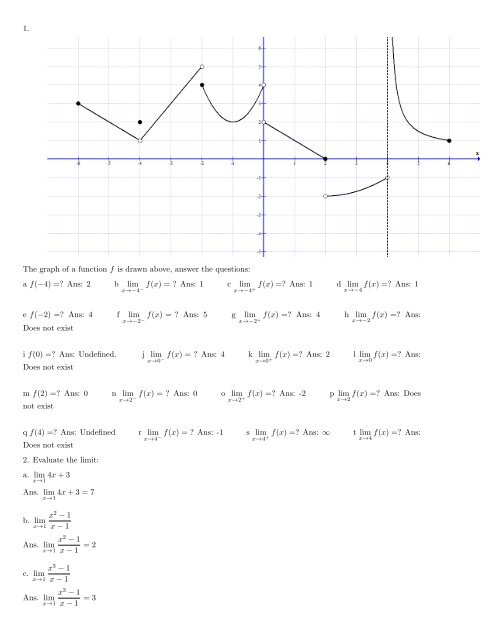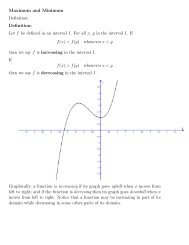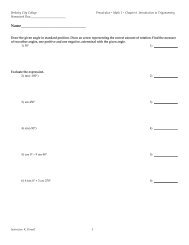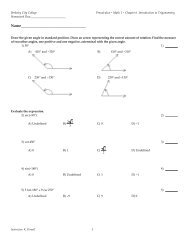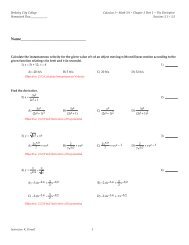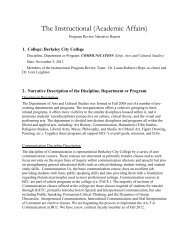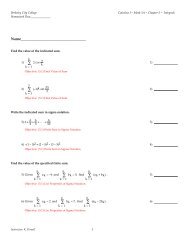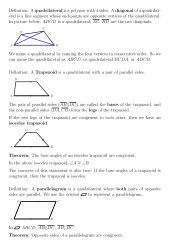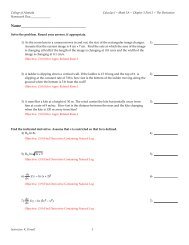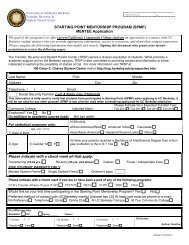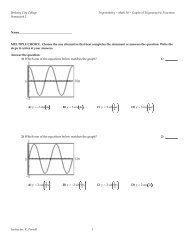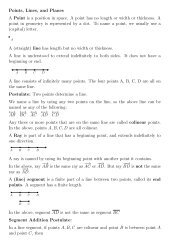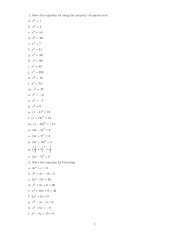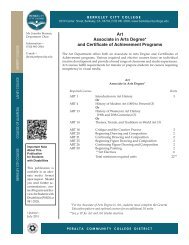Ans: 1 c lim f(x) - Berkeley City College
Ans: 1 c lim f(x) - Berkeley City College
Ans: 1 c lim f(x) - Berkeley City College
Create successful ePaper yourself
Turn your PDF publications into a flip-book with our unique Google optimized e-Paper software.
1.<br />
The graph of a function f is drawn above, answer the questions:<br />
a f(−4) =? <strong>Ans</strong>: 2 b <strong>lim</strong> f(x) = ? <strong>Ans</strong>: 1 c <strong>lim</strong> f(x) =? <strong>Ans</strong>: 1 d <strong>lim</strong> f(x) =? <strong>Ans</strong>: 1<br />
x→−4 − x→−4 + x→−4<br />
e f(−2) =? <strong>Ans</strong>: 4 f <strong>lim</strong> f(x) = ? <strong>Ans</strong>: 5 g <strong>lim</strong> f(x) =? <strong>Ans</strong>: 4 h <strong>lim</strong> f(x) =? <strong>Ans</strong>:<br />
x→−2 − x→−2 + x→−2<br />
Does not exist<br />
i f(0) =? <strong>Ans</strong>: Undefined. j <strong>lim</strong> f(x) = ? <strong>Ans</strong>: 4 k<br />
x→0− Does not exist<br />
<strong>lim</strong> f(x) =? <strong>Ans</strong>: 2 l<br />
x→0 +<br />
<strong>lim</strong> f(x) =? <strong>Ans</strong>:<br />
x→0<br />
m f(2) =? <strong>Ans</strong>: 0 n <strong>lim</strong> f(x) = ? <strong>Ans</strong>: 0 o <strong>lim</strong> f(x) =? <strong>Ans</strong>: -2 p<br />
x→2− x→2 +<br />
not exist<br />
<strong>lim</strong> f(x) =? <strong>Ans</strong>: Does<br />
x→2<br />
q f(4) =? <strong>Ans</strong>: Undefined<br />
Does not exist<br />
r <strong>lim</strong><br />
x→4 − f(x) = ? <strong>Ans</strong>: -1<br />
s <strong>lim</strong><br />
x→4 + f(x) =? <strong>Ans</strong>: ∞<br />
t <strong>lim</strong><br />
x→4<br />
f(x) =? <strong>Ans</strong>:<br />
2. Evaluate the <strong>lim</strong>it:<br />
a. <strong>lim</strong><br />
x→1<br />
4x + 3<br />
<strong>Ans</strong>. <strong>lim</strong><br />
x→1<br />
4x + 3 = 7<br />
b. <strong>lim</strong><br />
x→1<br />
x 2 − 1<br />
x − 1<br />
<strong>Ans</strong>. <strong>lim</strong><br />
x→1<br />
x 2 − 1<br />
x − 1 = 2<br />
c. <strong>lim</strong><br />
x→1<br />
x 3 − 1<br />
x − 1<br />
<strong>Ans</strong>. <strong>lim</strong><br />
x→1<br />
x 3 − 1<br />
x − 1 = 3
d. <strong>lim</strong><br />
x→1<br />
x − 1<br />
x 2 − 1<br />
<strong>Ans</strong>. <strong>lim</strong><br />
x→1<br />
x − 1<br />
x 2 − 1 = 1 2<br />
e. <strong>lim</strong><br />
x→1<br />
x − 1<br />
x 2 − 2x + 1<br />
<strong>Ans</strong>. <strong>lim</strong><br />
x→1<br />
x − 1<br />
x 2 − 2x + 1 = DNE<br />
x 2 − 5x<br />
f. <strong>lim</strong><br />
x→5 x 2 + 2x − 35<br />
x 2 − 5x<br />
<strong>Ans</strong>. <strong>lim</strong><br />
x→5 x 2 + 2x − 35 = 5<br />
12<br />
g. <strong>lim</strong><br />
x→7<br />
√ x + 2 − 3<br />
x − 7<br />
√ x + 2 − 3<br />
<strong>Ans</strong>: <strong>lim</strong><br />
= 1<br />
x→7 x − 7 6<br />
h. <strong>lim</strong><br />
x→0<br />
sin x<br />
x<br />
<strong>Ans</strong>. <strong>lim</strong><br />
x→0<br />
sin x<br />
x = 1<br />
i. <strong>lim</strong><br />
x→2<br />
f(x) − f(2)<br />
x − 2<br />
f(x) − f(2)<br />
<strong>Ans</strong>. <strong>lim</strong><br />
= 3<br />
x→2 x − 2<br />
j. <strong>lim</strong><br />
x→3<br />
f(x) − f(3)<br />
x − 3<br />
f(x) − f(3)<br />
<strong>Ans</strong>. <strong>lim</strong><br />
= 6<br />
x→3 x − 3<br />
k. <strong>lim</strong><br />
x→c<br />
f(x) − f(c)<br />
x − c<br />
f(x) − f(c)<br />
<strong>Ans</strong>. <strong>lim</strong><br />
= 4c<br />
x→c x − c<br />
l. <strong>lim</strong><br />
h→0<br />
f(x + h) − f(x)<br />
h<br />
if f(x) = 3x + 1<br />
if f(x) = x 2 − 1<br />
if f(x) = 2x 2<br />
f(x + h) − f(x)<br />
<strong>Ans</strong>: <strong>lim</strong><br />
= −4<br />
h→0 h<br />
m. <strong>lim</strong><br />
h→0<br />
f(x + h) − f(x)<br />
h<br />
if f(x) = −4x − 2<br />
if f(x) = sin x<br />
f(x + h) − f(x)<br />
<strong>Ans</strong>: <strong>lim</strong><br />
= cos x<br />
h→0 h<br />
n. <strong>lim</strong><br />
h→0<br />
f(x + h) − f(x)<br />
h<br />
if f(x) = cos x<br />
f(x + h) − f(x)<br />
<strong>Ans</strong>: <strong>lim</strong><br />
= − sin x<br />
h→0 h<br />
o. <strong>lim</strong><br />
x→2 − |x − 2|<br />
x − 2<br />
<strong>Ans</strong>: −1
p. <strong>lim</strong><br />
x→2 + |x − 2|<br />
x − 2<br />
<strong>Ans</strong>: 1<br />
x<br />
q. <strong>lim</strong><br />
x→−1 − x + 1<br />
<strong>Ans</strong>: ∞<br />
x<br />
r. <strong>lim</strong><br />
x→−1 + x + 1<br />
<strong>Ans</strong>: −∞<br />
3. Let<br />
⎧<br />
⎨ x 2 + 1 if x < −3<br />
f(x) = x − 2 if − 3 ≤ x < 9<br />
⎩ √ x if 9 ≤ x<br />
Evaluate:<br />
a. <strong>lim</strong><br />
x→−3 − f(x)<br />
<strong>Ans</strong>: 10<br />
b. <strong>lim</strong><br />
x→−3 + f(x)<br />
<strong>Ans</strong>: −5<br />
c. <strong>lim</strong><br />
x→−3 f(x)<br />
<strong>Ans</strong>: Limit Does Not Exist.<br />
d. <strong>lim</strong><br />
x→−1 − f(x)<br />
<strong>Ans</strong>: −3<br />
e. <strong>lim</strong><br />
x→−1 + f(x)<br />
<strong>Ans</strong>: −3<br />
f. <strong>lim</strong><br />
x→−1 f(x)<br />
<strong>Ans</strong>: −3<br />
g. <strong>lim</strong><br />
x→0 − f(x)<br />
<strong>Ans</strong>: −2<br />
h. <strong>lim</strong><br />
x→0 + f(x)<br />
<strong>Ans</strong>: −2<br />
i. <strong>lim</strong><br />
x→0<br />
f(x)<br />
<strong>Ans</strong>: −2<br />
j. <strong>lim</strong><br />
x→2 − f(x)<br />
<strong>Ans</strong>: 0<br />
k. <strong>lim</strong><br />
x→2 + f(x)<br />
<strong>Ans</strong>: 0<br />
l. <strong>lim</strong><br />
x→2<br />
f(x)
<strong>Ans</strong>: 0<br />
m. <strong>lim</strong><br />
x→9 − f(x)<br />
<strong>Ans</strong>: 7<br />
n. <strong>lim</strong><br />
x→9 + f(x)<br />
<strong>Ans</strong>: 3<br />
o. <strong>lim</strong><br />
x→9<br />
f(x)<br />
<strong>Ans</strong>: Limit Does Not Exist<br />
p. <strong>lim</strong><br />
x→16 − f(x)<br />
<strong>Ans</strong>: 4<br />
q. <strong>lim</strong><br />
x→16 + f(x)<br />
<strong>Ans</strong>: 4<br />
r. <strong>lim</strong><br />
x→16 f(x)<br />
<strong>Ans</strong>: 4<br />
4. Think about:<br />
For any real number x, let f be defined by:<br />
What is <strong>lim</strong><br />
x→0<br />
f(x)?<br />
<strong>Ans</strong>: Limit Does Not Exist.<br />
f(x) =<br />
5. For any real number x, let f be defined by:<br />
What is <strong>lim</strong><br />
x→0<br />
f(x)?<br />
<strong>Ans</strong>: 0<br />
⎧<br />
⎪⎨<br />
f(x) =<br />
⎪⎩<br />
{ 0 if x is irrational<br />
1 if x is rational<br />
0 if x is irrational<br />
0 if x = 0<br />
1<br />
n<br />
if x ≠ 0, x = m , m, n are co-prime, n > 0<br />
n<br />
6. For the following given function f, find the point(s) where f is discontinuous. Catagorize the point(s) you<br />
found as removable or unremovable discontinuity. If the point is a removable discontinuity, explain how you can<br />
redefine the function at that point to make the function continuous at that point.<br />
a. f(x) = 5<br />
<strong>Ans</strong>: f is continuous on whole real line.<br />
b. f(x) = x 3 + 2x + 7<br />
<strong>Ans</strong>: f is continuous on whole real line.<br />
c. f(x) = |x|<br />
<strong>Ans</strong>: f is continuous on whole real line.<br />
d. f(x) = sin x<br />
x
<strong>Ans</strong>: f is discontinuous at x = 0. Define f(x) = 1 if x = 0 and f will be continuous at 0, so x = 0 is a removable<br />
discontinuity.<br />
e. f(x) = x2 − 3x + 2<br />
x 2 − 4<br />
<strong>Ans</strong>: f is discountinuous at x = −2 and x = 2. Define f(x) = 1 if x = 2, and f will be continuous at 2, so x = 2<br />
4<br />
is a removable discontinuity. <strong>lim</strong> f(x) does not exist, so x = −2 is a non-removable discontinuity.<br />
x→−2<br />
f. f(x) =<br />
|x + 4|<br />
x + 4<br />
<strong>Ans</strong>: f is discontinuous at x = −4. This is a non-removable discontinuity.<br />
g. f(x) = e −1/x2<br />
<strong>Ans</strong>: f is discontinuous at x = 0. Define f(x) = 0 if x = 0 will make f continuous at 0, so x = 0 is a removable<br />
discontinuity.<br />
⎧<br />
⎨ x + 3 if x < −1<br />
h. f(x) = x 2 + 1 if − 1 ≤ x < 4<br />
⎩<br />
−2x + 10 if 4 ≤ x<br />
<strong>Ans</strong>: f has a non-removable discontinuity at x = 4.<br />
⎧<br />
⎨ 2 if x ≤ 3<br />
i. f(x) = x − 1 if 3 ≤ x < 5<br />
⎩<br />
2x − 3 if 5 ≤ x<br />
<strong>Ans</strong>: f has a non-removable discontinuity at x = 5.<br />
7. Using the same graph of the function at problem (1), answer the following question:<br />
a. For which value(s) of x does f have a removable discontinuity?<br />
<strong>Ans</strong>: x = −4<br />
b. For which value(s) of x does f have a non-removable discontiuity?<br />
<strong>Ans</strong>: x = −2, x = 0, x = 2, x = 4<br />
c. For which value(s) of x is f discontinuous but has a <strong>lim</strong>it?<br />
<strong>Ans</strong>: x = −4<br />
d. For which value(s) of x is f discontinuous and not have a <strong>lim</strong>it, but has a left and/or right hand <strong>lim</strong>it?<br />
<strong>Ans</strong>: x = −2, x = 0, x = 2, x = 4<br />
e. For which value(s) of x does f not have any left or right hand <strong>lim</strong>it?<br />
<strong>Ans</strong>: None.<br />
8. Find the slope of the tangent line to the given function at the give value of x, using the <strong>lim</strong>it definition.<br />
a. f(x) = 3, x = −2<br />
<strong>Ans</strong>: m = 0<br />
b. f(x) = 3x + 1, x = 1<br />
<strong>Ans</strong>: m = 3<br />
c. f(x) = x 2 − 1, x = 3<br />
<strong>Ans</strong>: m = 6<br />
d. f(x) = √ x, x = 9<br />
<strong>Ans</strong>: m = 1 6<br />
9. For the functions in (8), find the equation of the tangent line to the given function at the give value of x.
a. <strong>Ans</strong>: y = 3<br />
b. <strong>Ans</strong>: y = 3x + 1<br />
c. <strong>Ans</strong>: y = 6x − 10<br />
d. <strong>Ans</strong>: y = 1 6 x + 3 2


